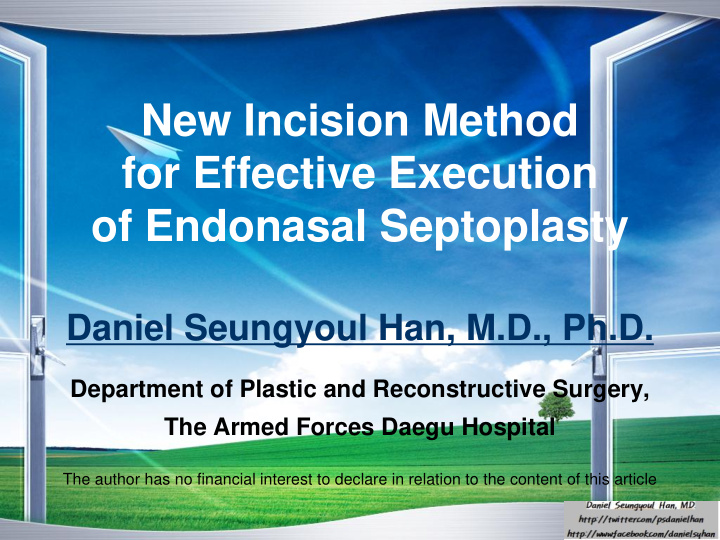



New Incision Method for Effective Execution of Endonasal Septoplasty Daniel Seungyoul Han, M.D., Ph.D. Department of Plastic and Reconstructive Surgery, The Armed Forces Daegu Hospital The author has no financial interest to declare in relation to the content of this article LOGO
Introduction Endonasal septoplasty -It is difficult to secure clear view since the n asal septum must be maximally exposed on ly with short vertical incision within the nasal cavity. Unnecessary damages to the nasal muco us membrane & Septal perforation
Introduction Therefore, Author have devised a new inci sion method in endonasal septoplasty -It can easily exfoliate and effectively expos e the nasal septum that the existing approa ch method and I am making report of the co mparison of my method with the existing me thods.
Materials and Methods Firstly, incision was made between a and a` on the median line of the existing modifie d Killian incision with interval of approximate ly 5mm using scalpel No. 15(Fig.1). The incision was extended to the both end s of a and a’ in radial direction that can be r eached with clear surgical view(Fig. 1).
Materials and Methods Fig. 1. Representative incision methods and my method of endonasal septoplasty
Materials and Methods Mucoperichondrial flap was exfoliated by using D-knife, cottle elevator and freer perio steal elevator. Simple suture with vicryl 5-0 was made at 2 locations, that is, at a and a’, after having collected the septum by leaving L-strut(Fig. 1).
Materials and Methods Endonasal septoplasty under the conditio ns that are the same as the existing 3 types of incision methods was performed 10 times The average duration of surgery using my method was compared with the other 3 met hods in order to determine the usefulness of my method at the time of septoplasty.
Results My incision method took the shortest time among the methods compared with average time of 10 minutes and 2 seconds in collecti ng the maximum quantity of septum while le aving the L-strut
Results
Discussion Membranous septum becomes an obstacl e in exfoliation of mucoperichondrial flap at t he time of septoplasty as it is firmly attache d to the frontal section of caudal septum(ap proximately 10mm)(Fig. 2).
Discussion Fig. 2. Mucoperichondrial flap of nasal septum
Discussion Therefore, it is difficult to exfoliate the fron tal portion of caudal septum but the lower a nd rear aspects can be approached relativel y easily at the time of mucoperichondrial fla p for septoplasty.
Discussion My incision method for endonasal septopl asty is compromise between the Killian incis ion that can easily exfoliate mucoperichondr ial flap and the modified Killian incision for w hich the manipulation of septum and suturin g of mucoperichondrial flap following collecti on of septum is easy.
Discussion By exfoliating the dense tissues in a relati vely small area of 5mm, it was possible to a ccurately perform septoplasty as it was pos sible to secure relative wider surgical view b y easily exfoliating the loose tissues. Suturing could be easily completed throug h simple suture only at a and a’ following col lection of the septum.
Conclusion For these reasons, my incision methods r ecommended as an effective incision metho d to be implemented in endonasal septoplas ty since it requires the shortest time for surg ery in comparison to the existing incision m ethods.
Recommend
More recommend